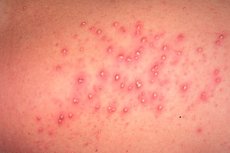Medical expert of the article
New publications
Consequences and complications of streptoderma
Last reviewed: 06.07.2025

All iLive content is medically reviewed or fact checked to ensure as much factual accuracy as possible.
We have strict sourcing guidelines and only link to reputable media sites, academic research institutions and, whenever possible, medically peer reviewed studies. Note that the numbers in parentheses ([1], [2], etc.) are clickable links to these studies.
If you feel that any of our content is inaccurate, out-of-date, or otherwise questionable, please select it and press Ctrl + Enter.

Sometimes the skin on the face or other exposed areas of the skin suddenly turns red, a blister filled with yellow liquid pops up, then it greatly increases, bursts, and a drying crust appears in its place. Then the rash increases exponentially, forming large foci that itch a lot. These symptoms are typical of a skin disease called streptoderma. Its pathogens are streptococci that penetrate the skin due to weakened immunity. The disease requires mandatory external treatment, and in some cases, antibiotics, immuno- and vitamin therapy. Serious complications of streptoderma may occur, and consequences in the form of marks on the body are also inevitable.
Relapse of streptoderma
Failure to comply with hygiene standards, violation of the treatment protocol, weak immunity, bathing in the first 3-5 days of the disease can cause complications both in the skin and other organs. Long-term streptoderma can lead to a relapse - a repeated outbreak. We are talking about the transition of pathology into a chronic form and requires treatment with hormonal ointments, drugs to strengthen the immune system. Long-term use of external antibiotics and antiseptics, in turn, can cause microbial eczema, fungal infection, guttate psoriasis, skin atrophy. Penetration of the streptococcal pathogen into the blood threatens very dangerous consequences, up to sepsis, meningitis, cerebral edema, pneumonia, rheumatism, scarlet fever, cardiovascular failure.
Post streptoderma spots
After timely treatment of streptoderma, spots remain on the skin in the places where yellowish crusts are located, formed as a result of the opening of phlyctenes (bubbles with serous fluid). They can be of different color intensity: from white and pink to purple and brown. You will have to walk with such consequences for at least a month, in addition, you need to properly care for them: cleanse the skin every day before going to bed, moisturize, apply nourishing creams, masks. Physiotherapy with ultraviolet light - irradiation of the affected areas and sunbathing - will speed up the process of skin renewal and restoration of its normal color.
Scars after streptoderma
Streptococci are capable of affecting not only the upper layer of the skin - the epidermis, but also the deeper one - the dermis. Various diseases that weaken the human immune system contribute to the involvement of deeper layers of the skin in the erosive process: HIV, tuberculosis, blood and lymph circulation disorders, diabetes, and vitamin deficiency. In this case, the resulting ulcers are more extensive and deep, so they leave rough scars and marks after drying and falling off the crust. Their localization on the face spoils the appearance and is very unpleasant, especially for women.
How to remove scars on the face from streptoderma?
There are currently many ways to remove scars from impetigo on the face. Among them:
- use of special ointments for scars;
- surgical excision;
- use of special ointments;
- cryodestruction;
- chemical peeling;
- laser resurfacing;
- application of silicone plates.
Of all the listed options, the best and most predictable result is obtained from laser resurfacing. It is applicable to scars of various origins, does it quickly, painlessly and without side effects.

